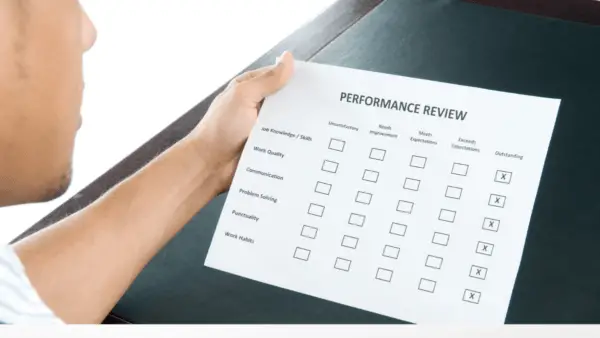Do you know how to write a performance review for remote workers? It’s essential to set clear expectations and keep track of changes in an employee’s work performance over time.
A performance review is critical to your remote employee’s career development and can make or break their performance. It will address their professional development, personal drivers, and behavioral issues. At the same time, a bad review will create unnecessary stress and conflict within your office team. That’s why it’s essential to be precise in your performance reviews.
In this article, I’ll explain how to give performance reviews for remote workers.
What Is a Performance Review?

Performance reviews are formal evaluations of how well an employee does their job. The evaluation process includes interviews with managers, observations of employees in the field, feedback from supervisors and co-workers, and any other information that sheds light on an employee’s strengths and weaknesses. This process helps managers determine whether employees are meeting their responsibilities at work and whether any areas need improvement.
Supervisors or team leaders also use it to gain insight into the strengths and weaknesses of your team members, but they also serve as an opportunity to identify areas for improvement in your team’s performance.
Why Do You Need To Perform Reviews for Remote Workers
Performance reviews are a forum for sharing information about an employee’s performance, strengths, and weaknesses and even better platforms for providing feedback on employees’ work habits, skills, and career development. Here are some of the benefits of conducting performance reviews:
- They offer the opportunity to recognize and reward employees for their contributions to the team, as well as provide feedback on areas where they can improve.
- They help you identify gaps in employee knowledge or skills.
- They offer a way for you to communicate with your team members about what they need to do better.
- They allow you to identify areas where employees could use more training or development opportunities.
- They allow you to provide feedback about specific issues or concerns the employee or supervisor raises.
- A performance review can also help you conduct an effective succession planning process by helping you identify future leaders or managers within your organization.
When giving performance reviews, it is important to give honest and factual performance reviews based on an employee’s performance data and not your biases. Statistics also show that 85% of employees would consider quitting if they feel they’ve received an unfair performance review.
5 Best Tips on How to Motivate Remote Employees
When Do You Need To Conduct A Performance reviews
There’s no set number of times you should conduct performance reviews in any given year; however, it is recommended that you conduct at least one per year and at least once every six months for employees who have been with your company for two years or more.
Ideally, a good performance review process involves giving feedback regularly throughout the year, including after any significant changes in position or responsibilities (such as promotions). That way, if there are any areas of improvement needed, they’ll be noticeable early on.
Performance reviews can be done using one-on-one meetings or group discussions, depending on the situation and the needs of all involved. Either way, they should be conducted with as much focus on learning as they are on evaluation.
Steps for Conducting Performance Reviews for Remote Workers.
When conducting performance reviews, there are three stages you need to go through, which are the pre-review, review and the post-review stage.
Pre-review stage
1. Set expectations.
If you are conducting the review over email or in person, take the time to set clear expectations about what you want to accomplish during the meeting. Make sure you communicate clearly before you begin, as this can help prevent misunderstandings later on.
2. Set ground rules for the meeting.
Before proceeding with the meeting, all parties involved must know what the meeting is about. If there’s anything out of the ordinary that will be discussed in the meeting, ensure to let the employee know of this before the meeting commences.
3. Follow meeting etiquette.
For your meeting to be productive, you must follow regular etiquette. This means ticking the box on everything you need to handle a productive meeting.
4: Identify the performance issues you want to address.
The first step in conducting a meaningful performance review is identifying areas where your employee needs improvement. This can be done by creating a list of specific goals for your employee, or it can be done by asking them about their most significant challenges and how they would like to improve on those challenges.
5. Performance reviews should be one-on-one
This goes without saying, but all performance reviews should only be with the employee in question. If you’re not their direct reporting manager, depending on the case, you may also include their managers as well. On no account should a performance review be done in a group or a team call, this is unless the entire team/group is being reviewed.
Review Stage
Step1. Set up a meeting.
Set up a meeting with your employee to discuss the goals you’ve identified. Once you have determined what areas need improvement, set up an appointment with your employee so that they can discuss their goals with you, via Zoom or Skype. During this meeting, discuss what steps they will take to achieve those goals and how they plan on working toward them. This will allow them to feel more committed and motivated before taking any steps forward.
Step 2. Be clear on expectations
Be clear about what you want from the employee. The best way to do this is by making your expectations as straightforward as possible in writing or verbally.
Step 3. Give Examples.
Give specific examples of how they met or exceeded expectations. For example, if you’re talking about time management, share an example of when they demonstrated their ability to manage their own time well — or not so well.
Step 4: Ask some questions.
Ask your employee what they like about working at your company and what they don’t like. There is no right or wrong answer here; just ask them how they feel about working at your company, then hear them out as far as their concerns go
Step 5: Ask how they manage their time.
6. Ask them if there are any changes in how they manage their time or projects that would help make life easier for them. If so, consider implementing those changes now while they are on board. If not, create a plan together to approach this issue in the future.
Step 6: Ask about what you can do to help them.
Ask your employee if there are any additional resources or projects that might help expand their skills and career potential? If so, consider funding those projects now while they are on board. If not, create a plan together to approach this issue in the future.
Post Review
Step 1: Communicate more effectively
Communicate any concerns or issues that may have been raised during the performance evaluation process with clarity and accuracy to avoid confusion later on down the road when it comes time for another review period with your employee’s manager or supervisor.
Step 2: Check in regularly or request regular updates
You must send out regular check-ins so you don’t lose track of your employees’ progress. If you want to be thorough, consider sending out weekly or monthly check-ins instead of just one annual review at the end of a year.
If you go the route of requesting regular updates, you must thread the line carefully as there’s a thin line between requesting regular updates and micromanaging your employees.
How to Give Performance Reviews to Remote Employees as A Team Leader
If you’re new to running a remote team, here are six steps for conducting a meaningful performance review:
- Know your team members’ strengths and weaknesses.
- Ask what their biggest challenges are in their current roles.
- Ask them how they’d like their next role to be different from the current one — whether that involves more work or less work, or something else entirely.
- Look for opportunities for growth within those challenges, and talk about how you can help them get there (if needed)
- Provide feedback on specific areas that could use improvement — but don’t focus on mistakes and failures; instead, focus on what worked well! Encouragingly praise success as much as possible, especially if there was a lot of hard work involved in achieving it (and make sure everyone knows what needs improvement).
- If possible, give feedback in person or via video conference call, so people know exactly where they stand with you and how you see them progressing over time.
Conclusion
If you’re a remote worker, we’re sure this was a helpful guide for you. And if you’re hiring remote workers, well, hopefully, it helped give you some insight into how to approach performance reviews with them. Ultimately, whatever your needs are for performance reviews, the principles about communication and understanding apply no matter where your employees work from. If you put in the effort to communicate more effectively with your employees, I’m sure they’ll appreciate it in the end.







